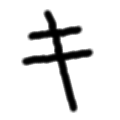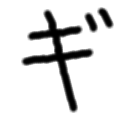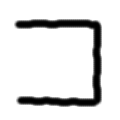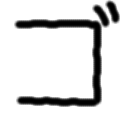KATAKANA LESSON TWO
In this lesson you will learn the Katakana form of the sounds KA, KI, KU, KE, KO, GA, GI, GU, GE, GO. To
see the stroke order, all you need to do is hover your mouse over the graphic of the character shown on the page. To hear
how to pronounce the characters, click your mouse on any picture of the character group.
You will notice that two lines are added to the K* characters to give the corresponding G* character. These two lines are
called (I don't remember), and they are used to represent the change in the vibrating of your throat when pronouncing
the original. KA with these two lines is a harsher version of KA, giving GA.
To feel this yourself, hold your hand to the hollow of your throat and compare the feeling from when you say ka versus
when you say ga. Try this also for sa and za, which you will learn about in a later lesson.
| KA/GA |
 |
 |
looks like Hiragana KA |
| KI/GI |
 |
 |
looks like Hiragana KI |
| KU/GU |
 |
 |
the long nose of a cook |
| KE/GE |
 |
 |
looks like a K |
| KO/GO |
 |
 |
it's a tennis court |
 |
Previous Lesson |
| | |
Next Lesson |
 |























